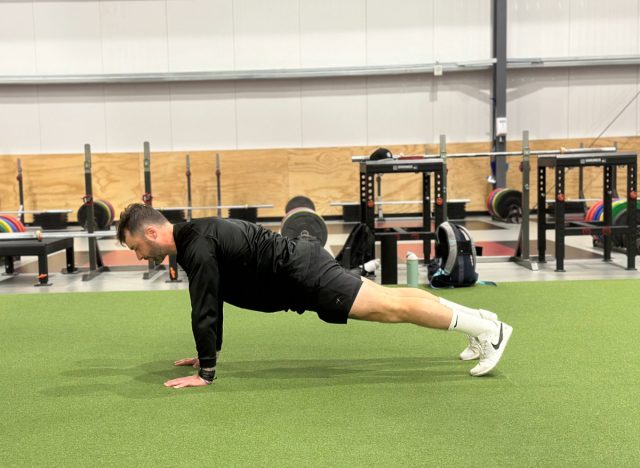The pushup is a classic for a reason—it’s one of the best bodyweight moves you can do, no matter where you are in your fitness journey. It’s a foundational exercise that builds strength and endurance in your chest, shoulders, triceps, and core—all while improving your joint stability and balance.
There are endless ways to modify pushups to fit your goals, whether you’re a beginner or a fitness pro. With countless progressions and regressions, you can make pushups as challenging or as accessible as you need. Add them to your workouts to boost strength, control, and functional fitness.
Table of Contents
Step-by-Step Guide
Step 1: Starting Position
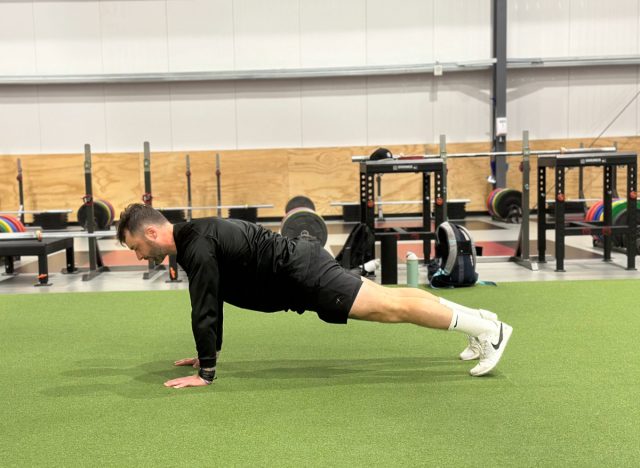

- Place your hands on the floor, shoulder-width apart, directly under your shoulders.
- Extend your legs back into a high plank position with your feet hip-width apart.
- Engage your core and keep your body straight from your head to your heels.
Step 2: Lowering Phase
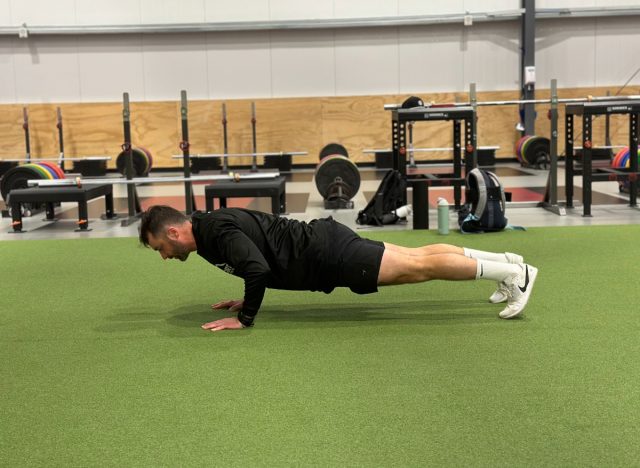

- Bend your elbows with control, lowering your chest toward the floor.
- Keep your elbows at a 45-degree angle to your body.
- Lower until your chest is above the ground, maintaining a neutral neck and straight back.
Step 3: Pressing Phase
- Push through your palms to lift your body back to the starting position.
- Fully extend your arms without locking elbows.
- Keep your body aligned and core tight, and avoid sagging hips to complete one repetition.
Form Tips:
- Maintain Alignment: Keep a straight line from your head to your heels. Avoid arching or sagging in the lower back, which can strain the spine.
- Engage Core and Glutes: Squeeze your core and glutes to maintain body tension and support proper alignment.
- Breathing: Inhale as you lower and exhale as you press up to maximize stability and muscle engagement.
- Hand Placement: Adjust your hand width slightly if you feel excessive strain on the shoulders or wrists.
Muscles Worked
The pushup primarily targets the pectoralis major (chest muscles), deltoids (shoulders), and triceps brachii (back of the arms). Secondary muscles include the core muscles (rectus abdominis, obliques, and transverse abdominis), serratus anterior (muscle near the ribs), and lower back muscles. These muscles work together to stabilize your body during the movement, making the pushup a total-body exercise that strengthens your upper body while improving core stability.
Benefits of the Pushup
Pushups build strength, power, and endurance in the upper body, making them beneficial for nearly any fitness goal. By training multiple muscle groups simultaneously, pushups enhance functional strength, helping with tasks requiring upper body and core power. The core engagement required during pushups also improves stability and posture, which can reduce the risk of injuries.
Pushups are adaptable, allowing you to progress or regress based on your fitness level. They don’t require any equipment, making them perfect for home workouts. When done correctly, they also support shoulder stability and joint health, promoting long-term fitness and resilience.
Common Mistakes and How to Avoid Them
- Sagging Hips: Letting your hips drop compromises your lower back and reduces core activation. Keep your body straight and engage your glutes and core to avoid this.
- Flaring Elbows: Elbows positioned too wide can strain the shoulder joint. To protect your shoulders, keep your elbows at a 45-degree angle.
- Inadequate Range of Motion: Lowering only halfway minimizes the pushup’s effectiveness. Lower your chest close to the ground without touching it.
- Neck Strain: Looking too far forward or downward can strain your neck. Keep a neutral gaze, looking slightly in front of your hands.
Exercise Variations
1. Standard Pushup (Beginner)
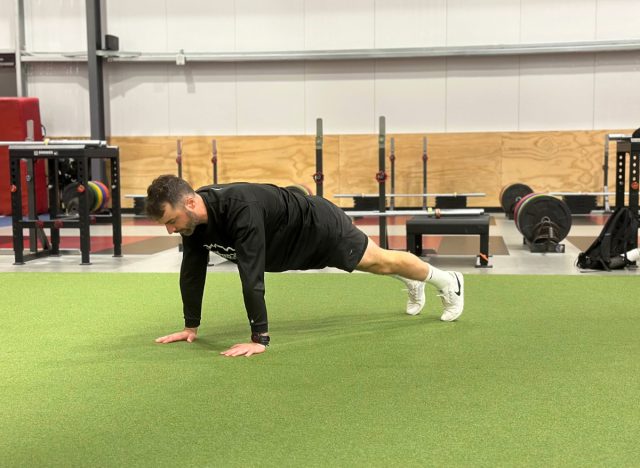

The standard pushup is a foundational move that builds upper body and core strength. It is ideal for beginners or anyone mastering the pushup form. It focuses on the chest, shoulders, and triceps while activating the core for stabilization.
How to Perform a Standard Pushup:
- Start in a high plank position with your hands shoulder-width apart and your body straight.
- Lower yourself by bending your elbows at a 45-degree angle, bringing your chest close to the ground.
- Press back up to the starting position, keeping your core tight throughout.
- Repeat for the desired number of reps.
2. Incline Pushup (Beginner/Regression)
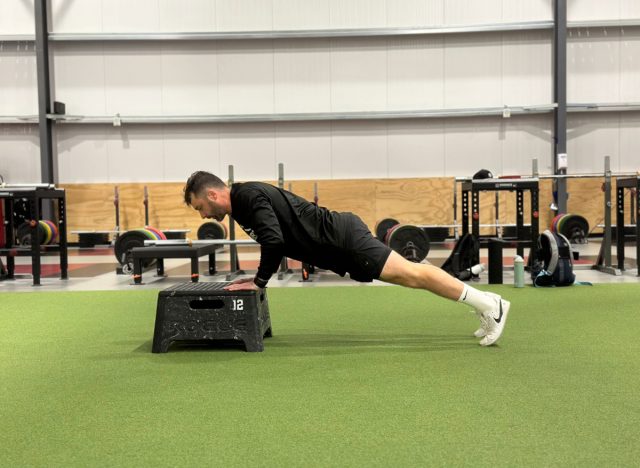

The incline pushup reduces the amount of weight you need to lift, making it perfect for beginners or those building upper-body strength. This variation also targets the chest, shoulders, and triceps with less intensity than a standard pushup.
How to Perform an Incline Pushup:
- Place your hands on an elevated surface, like a bench or step, shoulder-width apart.
- Bend your elbows to keep your body straight as you lower your chest toward the elevated surface.
- Push through your palms to return to the starting position.
- Perform the desired reps.
3. Close-Grip (Diamond) Pushup (Intermediate)
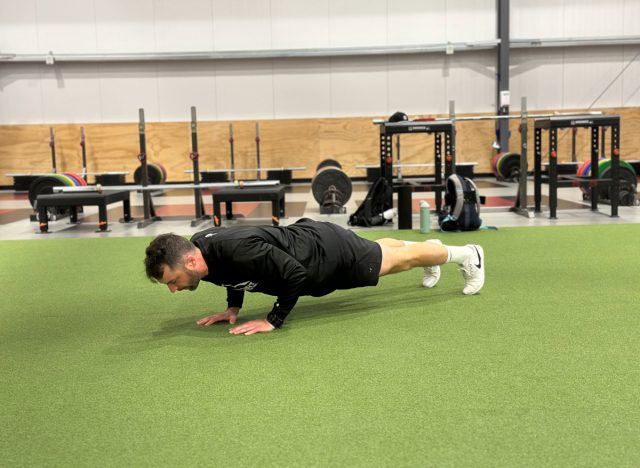

The close-grip pushup, also known as the diamond pushup, is a progression that emphasizes the triceps and inner chest muscles, increasing the challenge on the upper body.
How to Perform a Close-Grip Pushup:
- Start in a high plank position, bringing your hands together under your chest to form a diamond shape with your fingers.
- Lower your body by bending your elbows, keeping them close to your sides.
- Push through your palms to return to the starting position, engaging your core and keeping your body aligned.
- Repeat for the desired number of reps.
4. Pushup with Shoulder Taps (Intermediate)
This variation incorporates shoulder taps to enhance core stability and coordination, making it a great option for intermediate exercisers.
How to Perform a Pushup with Shoulder Taps:
- Begin in a high plank position with your hands shoulder-width apart.
- Perform a standard pushup by lowering your chest toward the ground and pressing back up.
- At the top of the pushup, lift one hand to tap the opposite shoulder, then switch to tap the other shoulder.
- Keep your hips stable and repeat for the desired reps or time.
5. Dumbbell Pushup (Advanced)
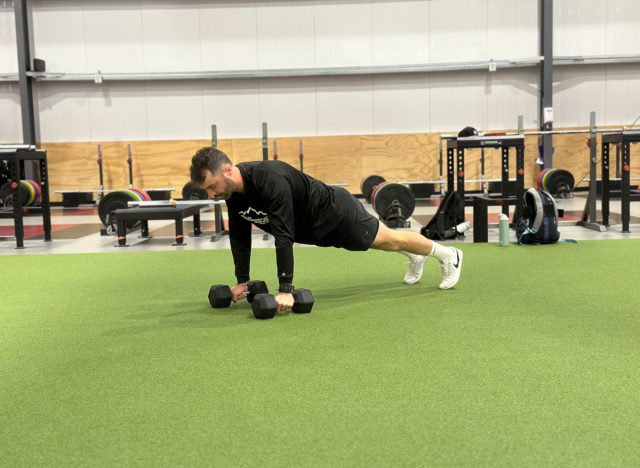

The dumbbell pushup increases the difficulty by elevating your grip and allowing for a deeper range of motion, activating the chest, shoulders, and core even more intensely.
How to Perform a Dumbbell Pushup:
- Hold a pair of dumbbells and position them shoulder-width apart on the floor.
- Assume a high plank position with your hands gripping the dumbbells.
- Lower yourself toward the floor, aiming to align your chest with the dumbbells.
- Press back up to the starting position, maintaining control and core engagement.
- Repeat for the desired number of reps.
6. Kneeling Pushup (Beginner/Regression)
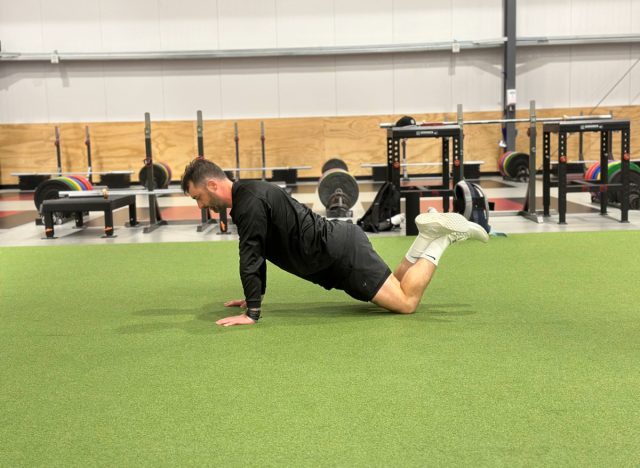

The kneeling pushup is a great starting point for those building upper-body strength or working on pushup form. By lowering the body’s weight load, this variation allows you to focus on technique while still targeting the chest, shoulders, and triceps.
How to Perform a Kneeling Pushup:
- Begin in a high plank position on your knees with your hands shoulder-width apart.
- Keep your body straight from your head to your knees, engaging your core.
- Lower your chest toward the floor by bending your elbows at a 45-degree angle.
- Push back up to the starting position, keeping your core tight.
- Repeat for the desired number of reps.
How to Incorporate Pushups Into a Workout
Start with 3-4 sets of 8 to 15 standard pushups for a balanced workout, or adjust based on your fitness level. Pushups work great in a full-body session, an upper-body or chest day, or even a HIIT circuit to elevate your heart rate and build cardiovascular endurance.
Once you’ve mastered the proper form, you can add weight to most variations to up your pushup game. Weighted pushups add intensity, helping you build serious strength. Other variations allow you to focus on specific muscle groups or dial back the intensity, making it easier to perfect your technique.
- For strength: Perform 3-4 sets of 5-8 reps with challenging variations or added weight.
- Rest Period: 90-120 seconds
- For muscle size: Aim for 3-4 sets of 8-15 reps, focusing on a consistent tempo.
- Rest Period: 30-60 seconds
- For endurance: Try 2-3 sets of 20+ reps, keeping your form tight throughout.
- Rest Period: 60-90 seconds
- For HIIT: Complete 3-4 rounds of 30-second intervals.
- Rest Interval: 20-30 seconds.
Conclusion
Mastering the pushup is a game-changer for building upper-body strength and core stability. With regular practice, you’ll gain functional power, better posture, and endurance that support everything from daily activities to intense workouts. Focus on nailing each rep with good form, and as you get stronger, you can start exploring the endless pushup variations to keep things fresh and challenging.
The best part? There’s a pushup for every fitness level and goal, making it easy to adapt this classic move to suit your needs.

